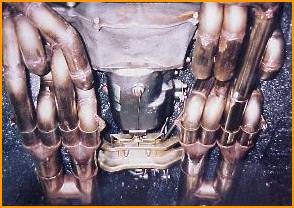You are using an out of date browser. It may not display this or other websites correctly.
You should upgrade or use an alternative browser.
You should upgrade or use an alternative browser.
(X) or (H) PIPE
- Thread starter grumpyvette
- Start date
philly
solid fixture here in the forum
more about the car here:
http://bangshift.com/bangshiftapex/...-all-at-talladega-with-this-boss-302-in-1969/
http://bangshift.com/bangshiftapex/...-all-at-talladega-with-this-boss-302-in-1969/
philly
solid fixture here in the forum
by the way to fit all that shit in there,,,, a cutom bellhousing, reverse rotation starter, and a flipped right hand drive steerring setup from an australian market ford falcon were used,,, im sure with 1000 other tricks we'll probably never know about. smokey yunick was one smart sonofabitch... every time i find something new that he had his hands on im amazed how far outside the box someone can possibly think.
8
87vette81big
Guest
I watched Grumpy.
More Apt to try out Flowmaster Scavenger series collectors on my T/A Big Tube Hooker Super Comp Headers.
Goal is to put Twin 4"ID Pipes on the car eventually.
Dual 3" inch has worked so nice in the past. I Love the Sound.
Every Hotrodder Racer does too.
X pipe is worth 15 Hp ?
I can make that up easy on Nitrous Oxide hit the switch button.
More Apt to try out Flowmaster Scavenger series collectors on my T/A Big Tube Hooker Super Comp Headers.
Goal is to put Twin 4"ID Pipes on the car eventually.
Dual 3" inch has worked so nice in the past. I Love the Sound.
Every Hotrodder Racer does too.
X pipe is worth 15 Hp ?
I can make that up easy on Nitrous Oxide hit the switch button.
yeah! but even with nitrous the better header design still tends to pull that extra torque over and above what you get with a dual exhaust, in fact its generally even more effective due to the larger gas volumes and higher pressure exhaust flow rates
cylinder fill efficiency is a compromise, your engine design is forced to make selecting the way components are matched, the factors of cam timing compression and exhaust header tuning all must fall in the same 3000 rpm power band and ideally in the same 1500 rpm range to maximize power.
the choices between cam timing and compression ratio, and head and intake flow rates, valve size and valve lift and duration,
has a huge effect on,exhaust scavenging and while most people think the port flow rate is mostly the result of the piston dropping away from TDC,
lowering the cylinder pressure , thus drawing in the intake runner charge, this is not the major factor once the engine rpms increase significantly.
its exhaust scavenging during the valve over lap , being well matched to the engine displacement and cam timing, header diameter, and length, and collector design,
and intake ram tuning that can significantly boost cylinder fill and cylinder scavenging efficiency rates.
OK, first fact! the piston can,t compress anything being trapped in the cylinder by the piston compressing it as it raises,until both valves seat & seal


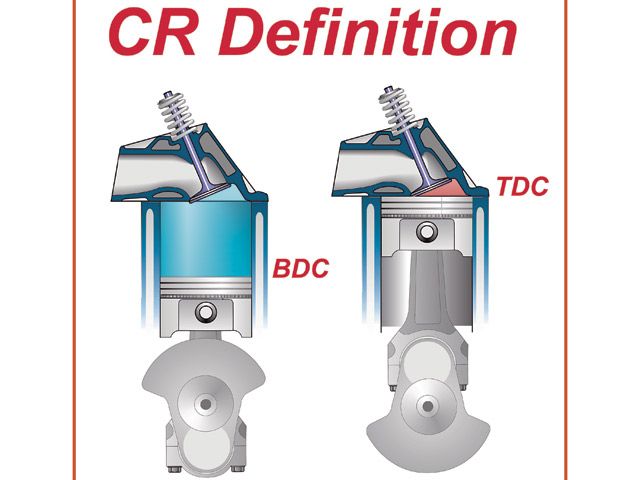
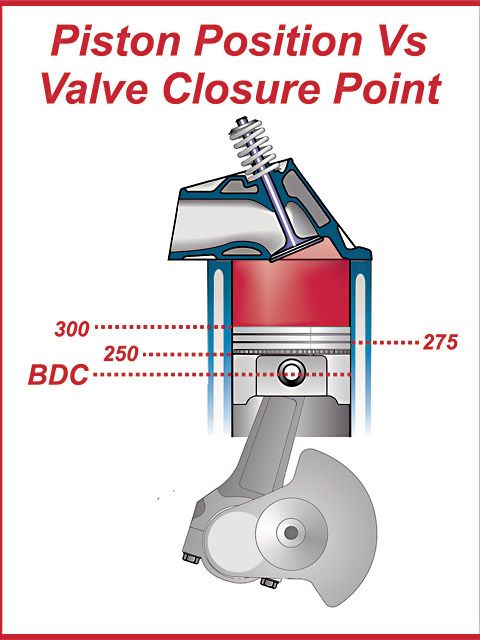

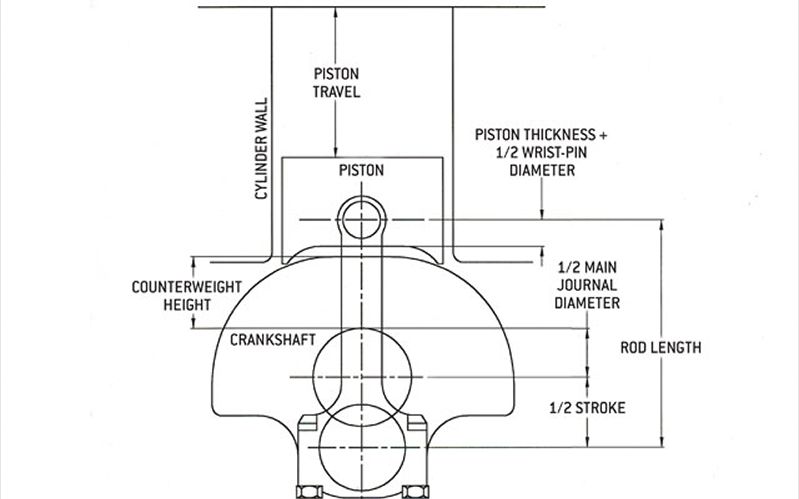
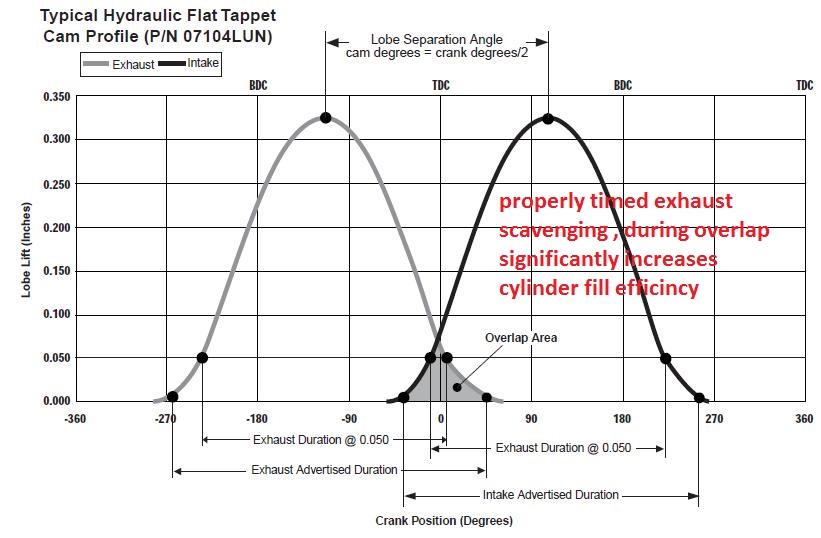
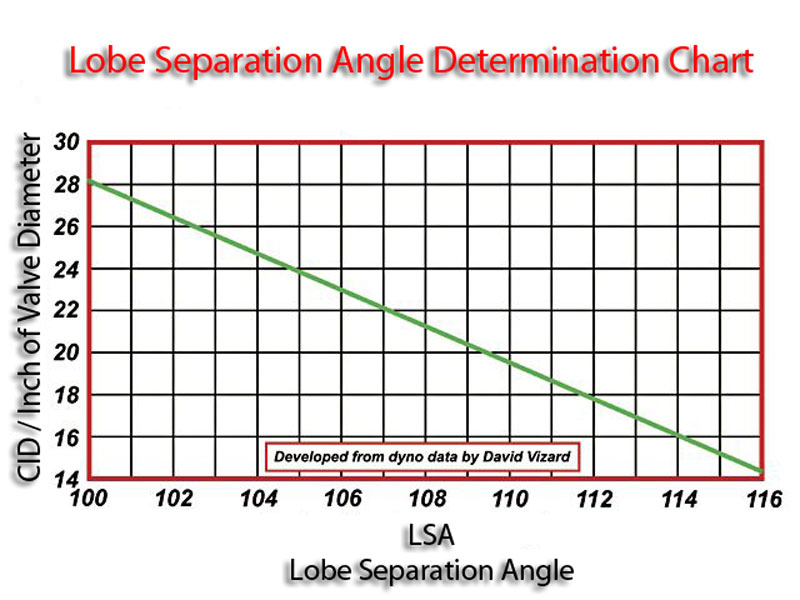
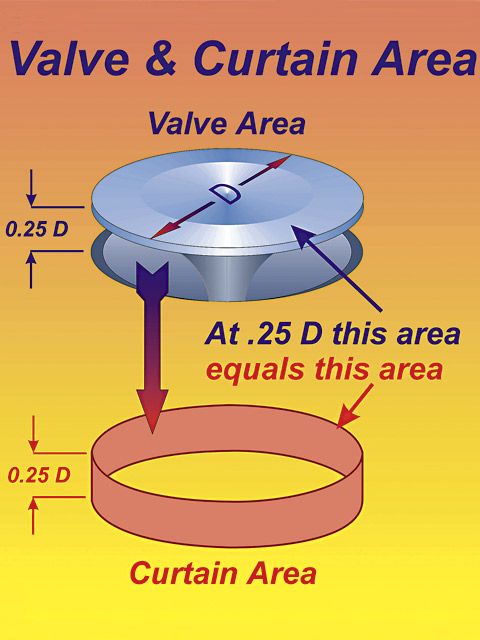
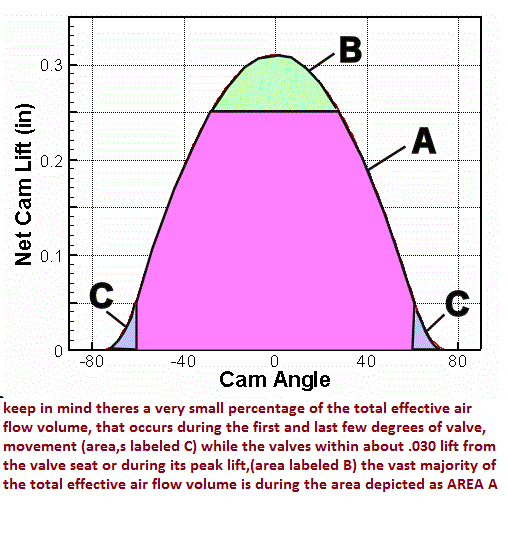
http://garage.grumpysperformance.com/index.php?threads/calculate-compression.9162/#post-32706
http://garage.grumpysperformance.co...lsa-effects-your-compression-torque-dcr.1070/
If your looking to reduce noise installing several x-pipes in series, blends and reduces the exhaust pulse strength,yes Im sure it could, if theres enough physical real estate under the car, or truck ,available to allow it to be installed,
but I found a full length 3" exhaust with just two 3" X-pipes mounted as close as you can get them too the header collectors

x-pipes like this in series and, two 3" inlet and dual outlet ,
mount the mufflers as far back as you can and be sure to have the tail pipes exit past the cars bumper and point back and downward at about a 45 degree exit,
what your trying to accomplish, is basically two goals,
(1) you want to keep the exhaust gas velocity fairly high so its exiting inertia will help scavenge the engines cylinders, on most mild street engines a 2.5" full length exhaust with an (X-PIPE) will be ok, but once you exceed about 370 cubic inches of displacement AND/OR 6000 rpm,
you can usually benefit from the larger and lower restriction of a full 3" exhaust system.
(2) obviously youll want significant noise reduction , below about 4000 rpm where youll spend more than 90% of the time driving on the street.

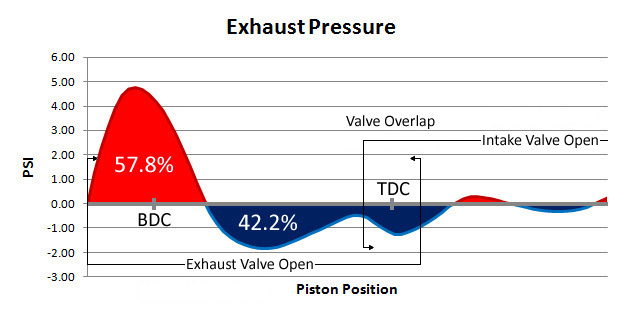

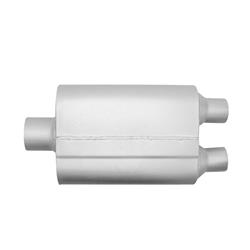
low flow restriction mufflers does a reasonably good job at reducing the sound levels, a 3" inlet and dual 2.25" outlet exhaust muffler design works reasonably well, but do your research as different brands have wildly different flow characteristics. and yes dual 2.25" outlets can flow equally to a single 3" inlet, and remember as the exhaust gases cool volume is reduced
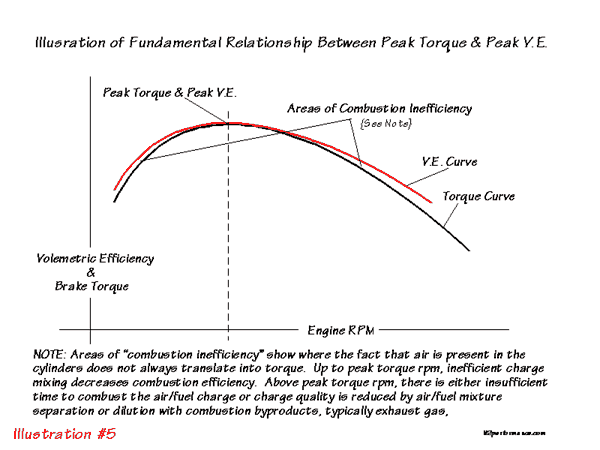
3" o.d = 2.87" diam. inside--approximately 6.5 sq inches of area
2.75 o.d = 2.62"diam. inside--approximately 5.4 sq inches of area
2.5 o.d = 2.37" diam. inside--approximately 4.4 sq inches of area
2.25 o.d = 2.12" diam. inside--approximately 3.5 sq inches of area
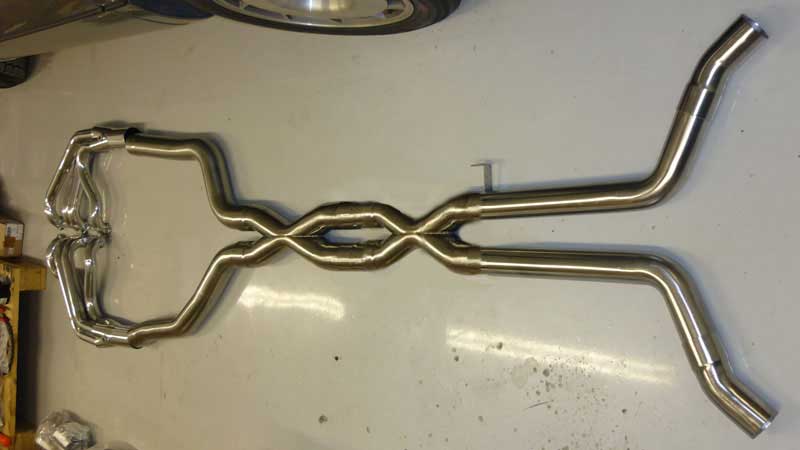

that adding just two, 3" x-pipes in close series does make a significant difference in noise levels , is well proven, if you could fit 3 that would certainly not hurt.
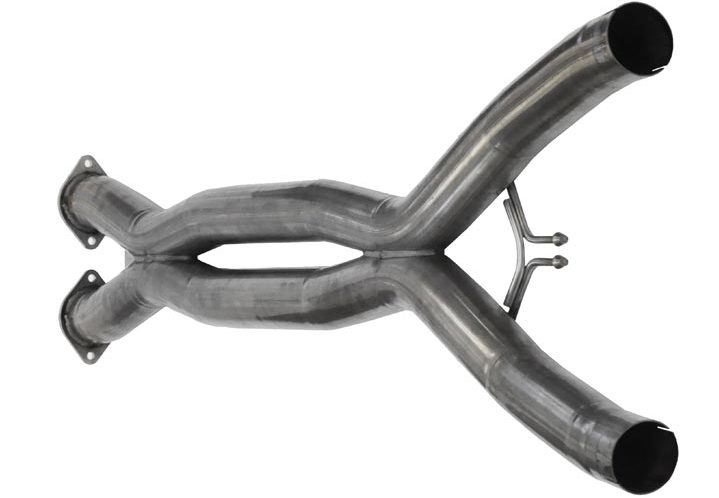
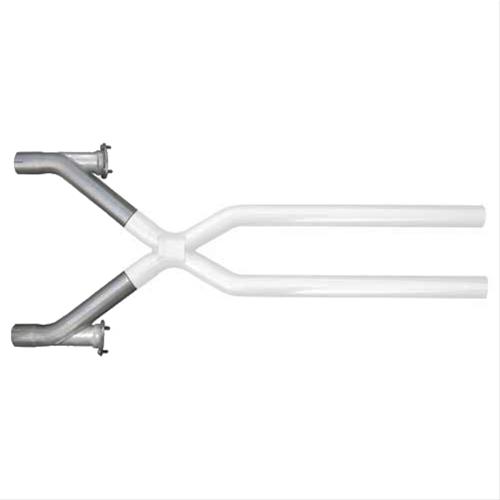
 www.summitracing.com
www.summitracing.com

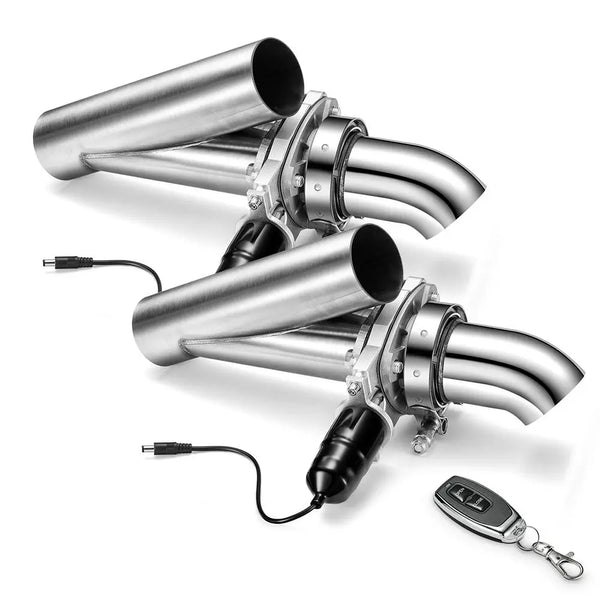
 www.spelabautoparts.com
www.spelabautoparts.com
GrumpyThe Grumpy Grease Monkey mechanical engineer.Staff Member
more numbers for ya'll who like numbers.

All tests via an independent lab
All tests @ 15” wc
2 “ Straight Pipe 283 CFM
2 ¼ “ Straight Pipe 365 CFM
2 ½ “ Straight Pipe 521 CFM
2 ¼” Typical Bent tailpipe 268 CFM
2 ½” Typical Bent Tailpipe 417 CFM
2 ¼” Inlet/Outlet_ Glass Pack Tips- No Louvers- Smooth 274 CFM
2 ¼” Inlet/Outlet- Glass Pack Tips-Louvered 133 CFM
Same as above set for reverse flow 141 CFM
2 ¼” Cherry Bomb 239 CFM
2 ½” Cherry Bomb 294 CFM
2 ½” Inlet/Outlet Dynomax Super Turbo 278 CFM
2 ½” Inlet/Outlet Ultraflow Bullet 512 CFM
2 ½” Inlet/Outlet Gibson Superflow 267 CFM
2 ½” Inlet/Outlet Flowmaster ( 2 Chamber) 249 CFM
2 ½” Inlet Outlet Flowmaster ( 3 Chamber) 229 CFM
2 ¼” Inlet/Outlet Thrush CVX 260 CFM
2 ½” Inlet/Outlet Maremount Cherry Bomb 298 CFM
2 ½” Inlet/Outlet Hooker Aero Chamber 324 CFM
2 ½” Inlet/Outlet Hooker Max Flow 521 CFM
2 ½” Inlet/Outlet Borla Turbo 373 CFM
2 1/2" Inlet/Outlet Magnaflow 284 CFM
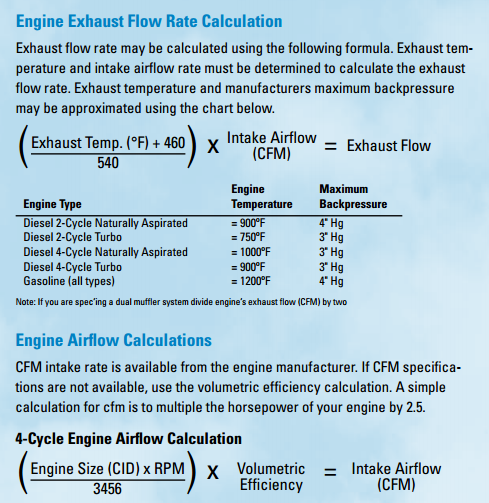
in the ideal exhaust system youll want to have less than .5
(thats 1/2 a PSI of back pressure) at the engines peak rpm

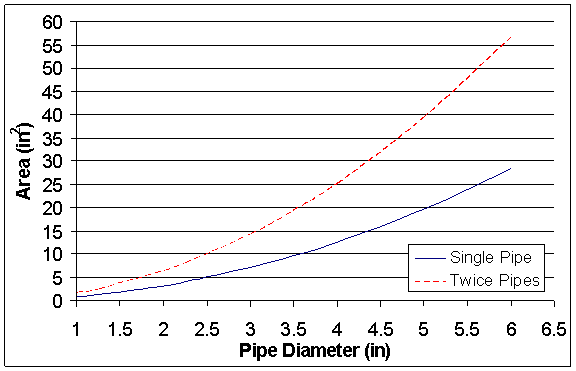
http://www.exhaustvideos.com/faq/how-to-calculate-muffler-size-pipe-diameter/
http://www.pontiacstreetperformance.com/psp/exhaust.html
http://www.mk5cortinaestate.co.uk/calculator5.php
http://forums.superchevy.com/super-...-calculate-muffler-size-and-exhaust-pipe-dia/
http://garage.grumpysperformance.com/index.php?threads/is-backpressure-hurting-your-combo.495/
http://garage.grumpysperformance.com/index.php?threads/x-or-h-pipe.1503/
http://garage.grumpysperformance.com/index.php?threads/calculating-required-exhaust-pipe-size.11552/
cylinder fill efficiency is a compromise, your engine design is forced to make selecting the way components are matched, the factors of cam timing compression and exhaust header tuning all must fall in the same 3000 rpm power band and ideally in the same 1500 rpm range to maximize power.
the choices between cam timing and compression ratio, and head and intake flow rates, valve size and valve lift and duration,
has a huge effect on,exhaust scavenging and while most people think the port flow rate is mostly the result of the piston dropping away from TDC,
lowering the cylinder pressure , thus drawing in the intake runner charge, this is not the major factor once the engine rpms increase significantly.
its exhaust scavenging during the valve over lap , being well matched to the engine displacement and cam timing, header diameter, and length, and collector design,
and intake ram tuning that can significantly boost cylinder fill and cylinder scavenging efficiency rates.
OK, first fact! the piston can,t compress anything being trapped in the cylinder by the piston compressing it as it raises,until both valves seat & seal










http://garage.grumpysperformance.com/index.php?threads/calculate-compression.9162/#post-32706
http://garage.grumpysperformance.co...lsa-effects-your-compression-torque-dcr.1070/
If your looking to reduce noise installing several x-pipes in series, blends and reduces the exhaust pulse strength,yes Im sure it could, if theres enough physical real estate under the car, or truck ,available to allow it to be installed,
but I found a full length 3" exhaust with just two 3" X-pipes mounted as close as you can get them too the header collectors

x-pipes like this in series and, two 3" inlet and dual outlet ,
mount the mufflers as far back as you can and be sure to have the tail pipes exit past the cars bumper and point back and downward at about a 45 degree exit,
what your trying to accomplish, is basically two goals,
(1) you want to keep the exhaust gas velocity fairly high so its exiting inertia will help scavenge the engines cylinders, on most mild street engines a 2.5" full length exhaust with an (X-PIPE) will be ok, but once you exceed about 370 cubic inches of displacement AND/OR 6000 rpm,
you can usually benefit from the larger and lower restriction of a full 3" exhaust system.
(2) obviously youll want significant noise reduction , below about 4000 rpm where youll spend more than 90% of the time driving on the street.




low flow restriction mufflers does a reasonably good job at reducing the sound levels, a 3" inlet and dual 2.25" outlet exhaust muffler design works reasonably well, but do your research as different brands have wildly different flow characteristics. and yes dual 2.25" outlets can flow equally to a single 3" inlet, and remember as the exhaust gases cool volume is reduced

3" o.d = 2.87" diam. inside--approximately 6.5 sq inches of area
2.75 o.d = 2.62"diam. inside--approximately 5.4 sq inches of area
2.5 o.d = 2.37" diam. inside--approximately 4.4 sq inches of area
2.25 o.d = 2.12" diam. inside--approximately 3.5 sq inches of area


that adding just two, 3" x-pipes in close series does make a significant difference in noise levels , is well proven, if you could fit 3 that would certainly not hurt.


Pypes Performance Exhaust XVX13F Pypes X-Pipe Dumps | Summit Racing
Free Shipping - Pypes X-Pipe Dumps with qualifying orders of $109. Shop Exhaust Crossover Pipes at Summit Racing.


SPELAB 2.0/2.25/2.5/3 Inch Dual Electric Exhaust Cutout Valve Remote Switch
SPELAB exhaust cutouts-Quickly and easily enhance performance as well as great exhaust sound. Fits exhaust pipe with diameters of 2.0", 2.25", 2.5" and 3.0".
GrumpyThe Grumpy Grease Monkey mechanical engineer.Staff Member
more numbers for ya'll who like numbers.

All tests via an independent lab
All tests @ 15” wc
2 “ Straight Pipe 283 CFM
2 ¼ “ Straight Pipe 365 CFM
2 ½ “ Straight Pipe 521 CFM
2 ¼” Typical Bent tailpipe 268 CFM
2 ½” Typical Bent Tailpipe 417 CFM
2 ¼” Inlet/Outlet_ Glass Pack Tips- No Louvers- Smooth 274 CFM
2 ¼” Inlet/Outlet- Glass Pack Tips-Louvered 133 CFM
Same as above set for reverse flow 141 CFM
2 ¼” Cherry Bomb 239 CFM
2 ½” Cherry Bomb 294 CFM
2 ½” Inlet/Outlet Dynomax Super Turbo 278 CFM
2 ½” Inlet/Outlet Ultraflow Bullet 512 CFM
2 ½” Inlet/Outlet Gibson Superflow 267 CFM
2 ½” Inlet/Outlet Flowmaster ( 2 Chamber) 249 CFM
2 ½” Inlet Outlet Flowmaster ( 3 Chamber) 229 CFM
2 ¼” Inlet/Outlet Thrush CVX 260 CFM
2 ½” Inlet/Outlet Maremount Cherry Bomb 298 CFM
2 ½” Inlet/Outlet Hooker Aero Chamber 324 CFM
2 ½” Inlet/Outlet Hooker Max Flow 521 CFM
2 ½” Inlet/Outlet Borla Turbo 373 CFM
2 1/2" Inlet/Outlet Magnaflow 284 CFM

in the ideal exhaust system youll want to have less than .5
(thats 1/2 a PSI of back pressure) at the engines peak rpm


http://www.exhaustvideos.com/faq/how-to-calculate-muffler-size-pipe-diameter/
http://www.pontiacstreetperformance.com/psp/exhaust.html
http://www.mk5cortinaestate.co.uk/calculator5.php
http://forums.superchevy.com/super-...-calculate-muffler-size-and-exhaust-pipe-dia/
http://garage.grumpysperformance.com/index.php?threads/is-backpressure-hurting-your-combo.495/
http://garage.grumpysperformance.com/index.php?threads/x-or-h-pipe.1503/
http://garage.grumpysperformance.com/index.php?threads/calculating-required-exhaust-pipe-size.11552/
Last edited by a moderator:
8
87vette81big
Guest
Those Damn Warbirds sure are intimidating to most aren't they Grumpy.
One FACT HOLDS TRUE...
ONLY THE BIG BLOCK CHEVY & PONTIAC 455 ROUND PORT HAS PROPERLY DESIGNED AFFORDABLE BIG TUBE 2.00" PRIMARY TUBES READILY AVAILABLE AND DON'T COST A MINT IN $.
One FACT HOLDS TRUE...
ONLY THE BIG BLOCK CHEVY & PONTIAC 455 ROUND PORT HAS PROPERLY DESIGNED AFFORDABLE BIG TUBE 2.00" PRIMARY TUBES READILY AVAILABLE AND DON'T COST A MINT IN $.
http://www.superchevy.com/how-to/exhaust/0505phr-exh/
http://www.hotrod.com/how-to/engine/mopp-0412-tti-exhaust-system-and-header-components/
http://garage.grumpysperformance.com/index.php?threads/building-an-exhaust-system-for-your-car.1166/
adding an X-pipe to a dual 3" exhaust behind your muslecars engine is almost always going to result in a bit mellower exhaust tone and at least a couple extra horse power due to the slightly lower back pressure and generally more effective exhaust scavenging it can allow
http://www.pontiacstreetperformance.com/psp/exhaust.html
http://www.pontiacstreetperformance.com/psp/exhaust3.html

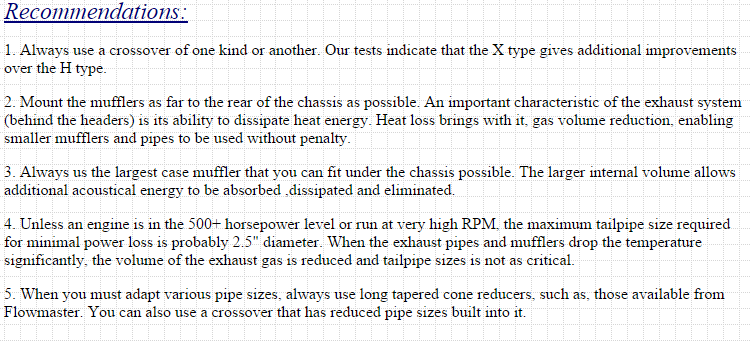
ID also point out that I rarely see dual 3" exhaust systems with an x-pipe not provide the best power
http://www.hotrod.com/how-to/engine/mopp-0412-tti-exhaust-system-and-header-components/
http://garage.grumpysperformance.com/index.php?threads/building-an-exhaust-system-for-your-car.1166/
adding an X-pipe to a dual 3" exhaust behind your muslecars engine is almost always going to result in a bit mellower exhaust tone and at least a couple extra horse power due to the slightly lower back pressure and generally more effective exhaust scavenging it can allow
http://www.pontiacstreetperformance.com/psp/exhaust.html
http://www.pontiacstreetperformance.com/psp/exhaust3.html


ID also point out that I rarely see dual 3" exhaust systems with an x-pipe not provide the best power
Last edited:
I can't help believing adding an "X" pipe even combined with the Super Dynamax mufflers has to be an improvement.
8
87vette81big
Guest
I hate the Sound of X-pipes .I can't help believing adding an "X" pipe even combined with the Super Dynamax mufflers has to be an improvement.
Whisper Quiet Stock.
Or Race Car Loud.
Only 2 choices for me.
8
87vette81big
Guest
Nothing Beats the Power of Open Headers Drag Racing.
think things thru carefully, not only will the components that you select for your exhaust system make a difference in engine efficiency ,so will their placement ,the fact is that headers only work efficiently if matched to an exhaust that provides little or no back pressure
headers function by using the inertial mass of the previous exhaust pulse to help cause a low pressure wave to help draw out the next exhaust pulse and thus draw in the next intake runner charge.
headers generally work most efficiently in the 4500-rpm-7000-rpm power band
IF the cam you select has a reasonably tight LSA,(104-108) that provides the overlap, in valve timing that will allow efficient cylinder scavenging
use the chart to get close to the ideal LSA, and in most cases installing the cam at split over lap, not 4 degrees advanced has advantages in reaching more peak hp.




as rpms increase so does the volume of exhaust gasses, and heat flowing through the exhaust, since the area and volume in that exhaust system will remain constant, the back pressure will increase unless the flow meets minimal resistance and has both the time and distance and surface area available to allow that heat and mass of gas to cool and expand and dissipate its energy.
I'm amazed at the number of guys that just don,t think about simple ways to reduce exhaust flow restrictions.
think about these factors , if you were to install a true dual exhaust with a muffler, mounted very close to the header collector exit point, the hot exhaust gases have a great deal less distance to travel and the exhaust pipe surface area is significantly less thus the exhaust heat has far less time and surface area to transfer heat and contract as it cools.
Compare that too a 3" exhaust pipe thats about 7 feet in length and a muffler thats about 22" long and 4" thick and 10" wide , mounted near the rear axle, would have about 1400 square inches of surface area to radiate heat, and about 1450 cubic inches of internal volume for those exhaust gasses to expand in, and cool in while it travels, temps generally drop about 500F between the exhaust port and tail pipe exit.
adding an (X) pipe close to the header collectors almost doubles the effective flow area simply because exhaust exits the engine spaced out in cylinder volume pulses spaced 90 degrees apart.
the use of an (x) pipe will almost always result i a measurable power increase over a true dual exhaust, and gains of 5-7 horse power are reasonably common, along with a change in the exhaust tone to a slightly higher tone but smoother sound at a slightly lower


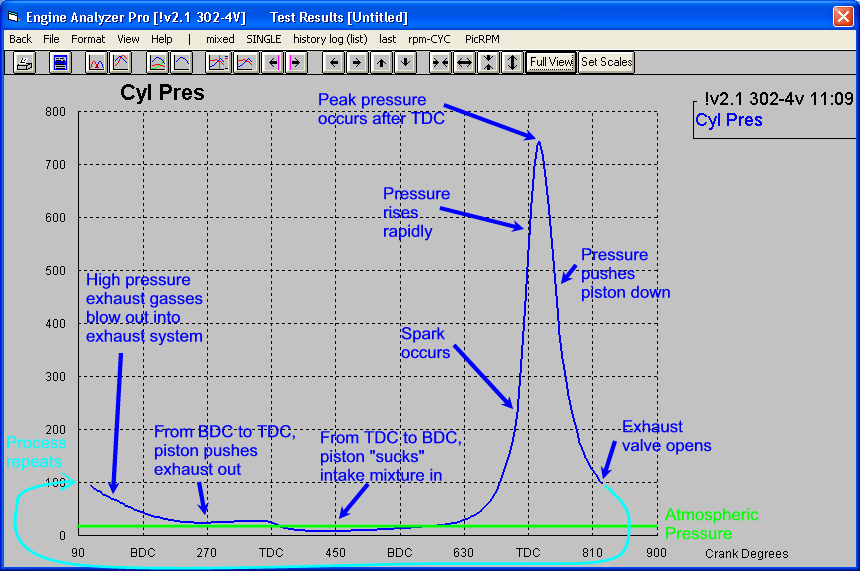

related info, you really should read
https://hydrogengarage.com/pdf/combustion info.pdf
http://garage.grumpysperformance.com/index.php?threads/calculating-required-exhaust-pipe-size.11552/
http://garage.grumpysperformance.com/index.php?threads/high-flow-quiet-exhaust.10558/
http://garage.grumpysperformance.com/index.php?threads/calculating-header-design.185/
http://garage.grumpysperformance.co...-guys-that-just-slap-on-factory-headers.3155/
http://garage.grumpysperformance.com/index.php?threads/building-an-exhaust-system-for-your-car.1166/
headers function by using the inertial mass of the previous exhaust pulse to help cause a low pressure wave to help draw out the next exhaust pulse and thus draw in the next intake runner charge.
headers generally work most efficiently in the 4500-rpm-7000-rpm power band
IF the cam you select has a reasonably tight LSA,(104-108) that provides the overlap, in valve timing that will allow efficient cylinder scavenging
use the chart to get close to the ideal LSA, and in most cases installing the cam at split over lap, not 4 degrees advanced has advantages in reaching more peak hp.




as rpms increase so does the volume of exhaust gasses, and heat flowing through the exhaust, since the area and volume in that exhaust system will remain constant, the back pressure will increase unless the flow meets minimal resistance and has both the time and distance and surface area available to allow that heat and mass of gas to cool and expand and dissipate its energy.
I'm amazed at the number of guys that just don,t think about simple ways to reduce exhaust flow restrictions.
think about these factors , if you were to install a true dual exhaust with a muffler, mounted very close to the header collector exit point, the hot exhaust gases have a great deal less distance to travel and the exhaust pipe surface area is significantly less thus the exhaust heat has far less time and surface area to transfer heat and contract as it cools.
Compare that too a 3" exhaust pipe thats about 7 feet in length and a muffler thats about 22" long and 4" thick and 10" wide , mounted near the rear axle, would have about 1400 square inches of surface area to radiate heat, and about 1450 cubic inches of internal volume for those exhaust gasses to expand in, and cool in while it travels, temps generally drop about 500F between the exhaust port and tail pipe exit.
adding an (X) pipe close to the header collectors almost doubles the effective flow area simply because exhaust exits the engine spaced out in cylinder volume pulses spaced 90 degrees apart.
the use of an (x) pipe will almost always result i a measurable power increase over a true dual exhaust, and gains of 5-7 horse power are reasonably common, along with a change in the exhaust tone to a slightly higher tone but smoother sound at a slightly lower




since the piston is 4" in diameter, the top surface of it is just PI * (4/2)2 or around 12.6 square inches. Each of those square inches experiences the 500 PSI(G) pressure (Pascal's Law), so the total force then instantaneously applied to the top of the piston is 12.6 * 500 or around 6300 pounds. (OK. It is ACTUALLY the 515 PSIA, but there is natural air pressure pressing against the UNDERSIDE of the piston as well, so the NET effect we are interested in is due to the GAUGE pressure. Not too different, but slightly!) But those aluminum alloy pistons in your engine are pretty amazing in being subject the 6300-pound force of hundreds of explosions pounding down on them every minute!
We might add a brief aside here, regarding an overview of a number of the things to be presented below. First, at this instant, the Overall Thermal Efficiency is amazingly high, more than 99%. That means that more than 99% of the chemical energy in the gasoline has now been converted into heat energy. Sounds impressive! Unfortunately, there is a (necessary) cooling system which will dispose of about 40% of that heat energy without it having done anything useful! And about another 40% of the heat energy will be sent out of the engine through the exhaust. Sadly, this only leaves around 20% of the actual chemical energy in the gasoline which is ACTUALLY USED to do anything useful! Put another way, when YOUR engine is producing 200 horsepower (150 kW) to drive your car, it actually had to produce about 1,000 horsepower (746 kW) worth of heat from gasoline, and then it DUMPS 400 horsepower (300 kW) worth by the operation of the cooling system and it dumps another 400 horsepower (300 kW) worth in the hot exhaust gases! Given that a lot of people have tried to work on improving internal combustion engines for more than a century, this is sort of disappointing news! It ALSO points out WHY people have thought up things like turbochargers (to try to capture some of the heat carried away in the exhaust) and WHY many small changes were made in and around engines to force them to run hotter, thereby slightly reducing the cooling system heat losses and slightly improving engine efficiency. Around 1975, they were happy to get 15% overall engine efficiency, which has now been raised to around 20% or even 21%. Yay!
Because of the geometry of the situation when the crankshaft has progressed 10° after TDC, the force diagram indicates that this downward force must be multiplied by (approximately) the sine of 10°, in order to determine the tangential force applied to the crankshaft. Approximately, because the connecting rod is no longer parallel with the axis of the cylinder bore, the actual angle being slightly higher, and an exact angle is easy to calculate with a thorough analysis. For now, 10° will give an approximate result for our purposes.
Therefore, at the instant which we are considering here, the tangential (rotative) force actually transferred to the crankshaft is around 6300 * sin(10) or 6300 * 0.174 or around 1100 pounds. Since this force is applied to the throw of the crankshaft, at 1.75" radius from the centerline of the crankshaft, the torque transferred to the crankshaft is therefore 1100 * 1.75" or 1100 * 0.146 foot or 160 foot-pounds of torque. This calculation is in ball-park agreement with the published maximum torque curves for such engines, at 1500 rpm.
Notice that the radial force applied to the crankshaft (bearings) is around 6300 * cos(10) or around 6200 pounds! At that moment, the vast majority of the power of the explosion is trying to drive the crankshaft down out of the engine, without rotating it! And in seriously trying to abuse the bearings! Without engine oil, under pressure, in the bearings, they do not last long with 6200 pounds force against them!
related info, you really should read
https://hydrogengarage.com/pdf/combustion info.pdf
http://garage.grumpysperformance.com/index.php?threads/calculating-required-exhaust-pipe-size.11552/
http://garage.grumpysperformance.com/index.php?threads/high-flow-quiet-exhaust.10558/
http://garage.grumpysperformance.com/index.php?threads/calculating-header-design.185/
http://garage.grumpysperformance.co...-guys-that-just-slap-on-factory-headers.3155/
http://garage.grumpysperformance.com/index.php?threads/building-an-exhaust-system-for-your-car.1166/
Last edited:
theres an endless list of reasons to own a decent MIG or TIG welder, heres an example I found posted
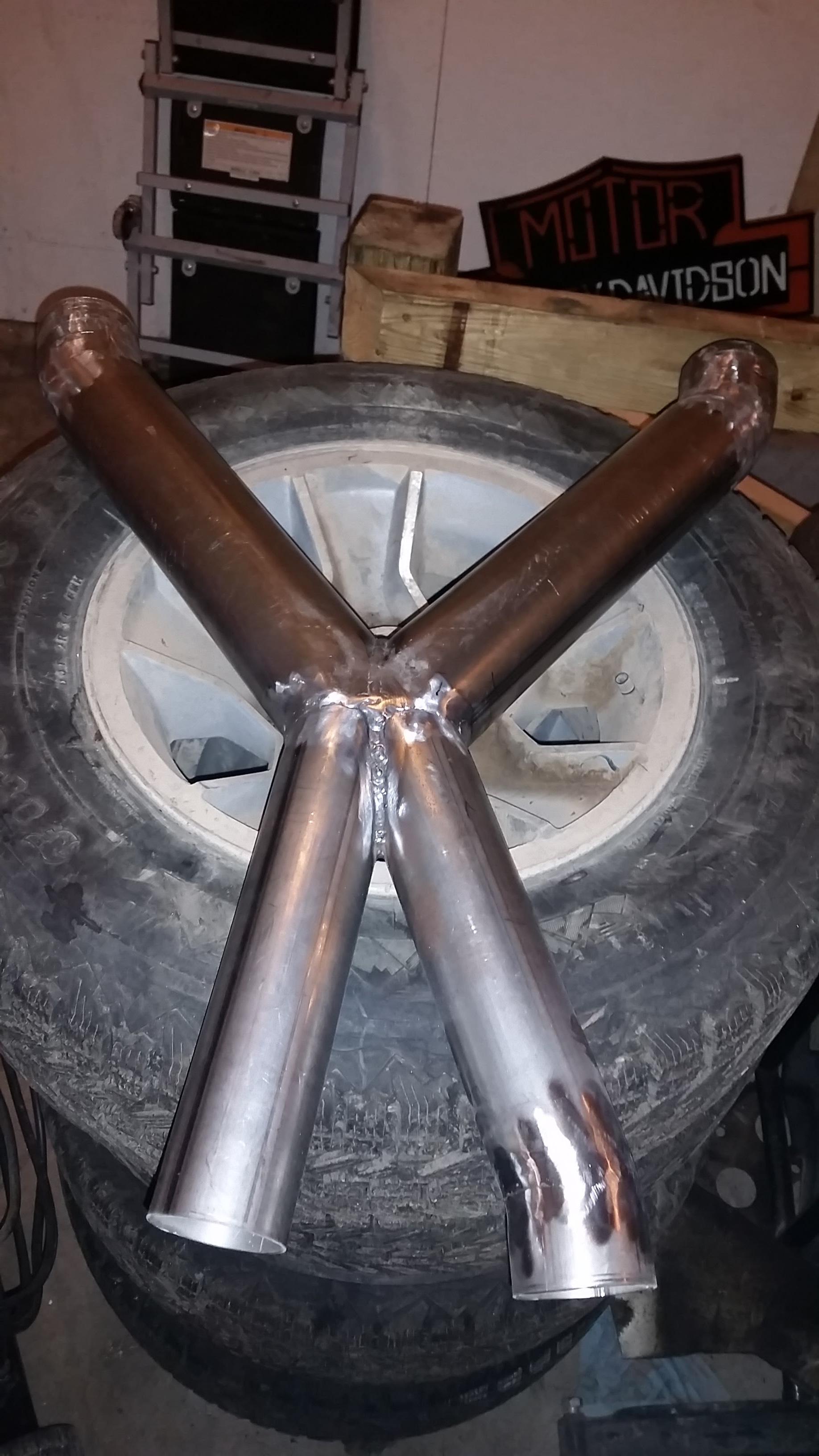
you don't need to go to an exhaust shop to get a kit fitted if you have basic fabrication skills and a cheap wire feed welder. you don't even need to buy the X pipe if you own a grinder and welder, i made an X pipe for my 86 Camaro a few weeks ago. it is 3" in/2.5" out and only cost me about $30 in material and a couple of hours to do it.. it's not show quality by any means, but some high temp paint and it will look pretty good. i know it sounds pretty damn wicked, and it will support much more than the 400ish hp that my 355 is putting out on a good day:

Gibbles
Clicker of buttons
I have come to like the sound of the x pipe on my C4 it makes the RPM sound a bit higher than it really is, currently I have the Melrose system with a single x pipe.
I contacted Melrose and they sold me a second x pipe, I plan on running it directly after the first and then continuing the 3in all the way to a set of FM40's.
I contacted Melrose and they sold me a second x pipe, I plan on running it directly after the first and then continuing the 3in all the way to a set of FM40's.


keep in mind that a properly designed exhaust system and headers goes a very long way towards increasing the efficiency of the intake manifold and head flow , and remember that the better the heads and the more effective the exhaust scavenging the less duration the cam used will require!
Ive installed something similar to this , built with two 3" (X) pipes ,on several cars in the past with good results
Last edited:
Loves302Chevy
"One test is worth a thousand expert opinions."

This is a work of art.
NewbVetteGuy
Well-Known Member
OMG. I love the double and triple x-pipe sound!
Thank for including the sound videos.
Earlier in this exhaust thread, there was a mention of the issue with a lot of overlap / extra exhaust duration, that you'll likely see exhaust temps rise and fuel economy drop because if you over-scavenge you'll end up pulling unburnt fuel out the exhaust.
-For the EFI geeks with modern, aftermarket sequential EFI systems there IS an option that allows you to "have your overlap cake and eat it, too": Open Valve Injection / End-of-Injection strategies. A number of aftermarket EFI platforms give you this ability and some include it by default when you're in a sequential configuration. The way that it works is that the EFI system times the fuel injection so that the fuel is injected timed backwards from a particular crank degree -usually x degrees before the intake closes. The EFI of course knows what pulse width the engine need so when you're demanding more power or at more RPMs, it just ends up injecting the fuel sooner and sooner.
---This means that it doesn't start injecting fuel until after overlap is over (at lower rpms and throttle positions(and "more injector", lets you avoid injecting on overlap for more and more of the power curve)), so you avoid the "over scavenging" fuel economy "tax"-in typical highway cruise situations, anyway, for sure. People who intentionally use this strategy / desire to only inject fuel when the intake valve is open (fuel is almost always injected at idle and after startup on a closed valve to improve idle quality by letting the hot intake valve atomize the fuel, but then systems transition to open valve injection later) AND not during overlap, simply have to size their injectors to be much larger than typical sizing guidelines (around 30% of duty cycle instead of around 80% for normal injector sizing) -this requires injectors that behave well at low pulse-widths AND requires that the injectors' low pulse width performance and latencies have been accurately "categorized" such that this data can be entered into the ECU. (Injector Dynamics provides this information to customers to input into their ECUs / give to their tuners, for this purpose, which is why you see Injector Dynamics' minimum injector sizes that are so large vs. a typical 80% sizing.(they can get away with large injectors because their injectors perform in "expected" ways at low pulse widths AND because they make high quality injector categorization data available to tuners.)
Bosch Mobility has started including the open valve injection strategy in the ECUs that they sell to big OEMs with port injected applications in recent years and Bosch has reported one additional benefit: because this strategy involves injecting a LOT of fuel just before the intake closes, more of the evaporative cooling benefit occurs in the CYLINDER vs. in the intake port, and Bosch has found that it allows them to run at +0.5 CR / +0.5 DCR as the cooling effect reduces the propensity to knock with the same octane fuel when they do this. ---> It kind of gets you SOME similar benefits to Direct Injection where you have ALL of the fuel's cooling capacity in the chamber, so you can run higher compression ratios.
-I'm really getting into EFI and I just find it super interesting how advanced port EFI is kind of a "middle ground" between throttle body-introduced fuel systems and direct injection and pushes back on some previous limitations / trade-offs that have to be made with systems that don't have it.
I plan to play with open valve / end-of-injection strategies while tuning my Holley HP. -I'm not sure how much I can take advantage of it as I have injectors that are sized @ 80% duty cycle, but we'll see how it goes.
I really think this strategy is applicable to the long-runner, high-power TPI engines that I love because they DO tend to be so octane-limited around the torque peak when you try to push the envelope and being able to run a bit more DCR / cylinder pressure without knock is particularly useful to these engines, IMHO.
Adam
Thank for including the sound videos.
Earlier in this exhaust thread, there was a mention of the issue with a lot of overlap / extra exhaust duration, that you'll likely see exhaust temps rise and fuel economy drop because if you over-scavenge you'll end up pulling unburnt fuel out the exhaust.
-For the EFI geeks with modern, aftermarket sequential EFI systems there IS an option that allows you to "have your overlap cake and eat it, too": Open Valve Injection / End-of-Injection strategies. A number of aftermarket EFI platforms give you this ability and some include it by default when you're in a sequential configuration. The way that it works is that the EFI system times the fuel injection so that the fuel is injected timed backwards from a particular crank degree -usually x degrees before the intake closes. The EFI of course knows what pulse width the engine need so when you're demanding more power or at more RPMs, it just ends up injecting the fuel sooner and sooner.
---This means that it doesn't start injecting fuel until after overlap is over (at lower rpms and throttle positions(and "more injector", lets you avoid injecting on overlap for more and more of the power curve)), so you avoid the "over scavenging" fuel economy "tax"-in typical highway cruise situations, anyway, for sure. People who intentionally use this strategy / desire to only inject fuel when the intake valve is open (fuel is almost always injected at idle and after startup on a closed valve to improve idle quality by letting the hot intake valve atomize the fuel, but then systems transition to open valve injection later) AND not during overlap, simply have to size their injectors to be much larger than typical sizing guidelines (around 30% of duty cycle instead of around 80% for normal injector sizing) -this requires injectors that behave well at low pulse-widths AND requires that the injectors' low pulse width performance and latencies have been accurately "categorized" such that this data can be entered into the ECU. (Injector Dynamics provides this information to customers to input into their ECUs / give to their tuners, for this purpose, which is why you see Injector Dynamics' minimum injector sizes that are so large vs. a typical 80% sizing.(they can get away with large injectors because their injectors perform in "expected" ways at low pulse widths AND because they make high quality injector categorization data available to tuners.)
Bosch Mobility has started including the open valve injection strategy in the ECUs that they sell to big OEMs with port injected applications in recent years and Bosch has reported one additional benefit: because this strategy involves injecting a LOT of fuel just before the intake closes, more of the evaporative cooling benefit occurs in the CYLINDER vs. in the intake port, and Bosch has found that it allows them to run at +0.5 CR / +0.5 DCR as the cooling effect reduces the propensity to knock with the same octane fuel when they do this. ---> It kind of gets you SOME similar benefits to Direct Injection where you have ALL of the fuel's cooling capacity in the chamber, so you can run higher compression ratios.
-I'm really getting into EFI and I just find it super interesting how advanced port EFI is kind of a "middle ground" between throttle body-introduced fuel systems and direct injection and pushes back on some previous limitations / trade-offs that have to be made with systems that don't have it.
I plan to play with open valve / end-of-injection strategies while tuning my Holley HP. -I'm not sure how much I can take advantage of it as I have injectors that are sized @ 80% duty cycle, but we'll see how it goes.
I really think this strategy is applicable to the long-runner, high-power TPI engines that I love because they DO tend to be so octane-limited around the torque peak when you try to push the envelope and being able to run a bit more DCR / cylinder pressure without knock is particularly useful to these engines, IMHO.
Adam

